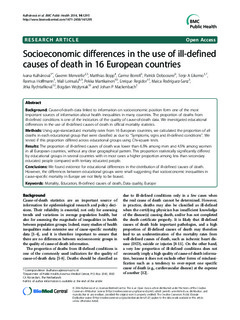| dc.contributor.author | Kulhanova, Ivana | |
| dc.contributor.author | Menvielle, G | |
| dc.contributor.author | Bopp, M | |
| dc.contributor.author | Borrell, C | |
| dc.contributor.author | Deboosere, P | |
| dc.contributor.author | Eikemo, Terje Andreas | |
| dc.contributor.author | Hoffmann, Rasmus | |
| dc.contributor.author | Leinsalu, M | |
| dc.contributor.author | Martikainen, P | |
| dc.contributor.author | Regidor, E | |
| dc.contributor.author | Rodriguez-Sanz, M | |
| dc.contributor.author | Rychtarikova, Jitka | |
| dc.contributor.author | Wojtyniak, Bogdan | |
| dc.contributor.author | Mackenbach, Johan P. | |
| dc.date.accessioned | 2015-09-11T12:42:10Z | |
| dc.date.accessioned | 2015-09-29T14:19:38Z | |
| dc.date.available | 2015-09-11T12:42:10Z | |
| dc.date.available | 2015-09-29T14:19:38Z | |
| dc.date.issued | 2014 | |
| dc.identifier.citation | BMC Public Health 2014, 14(1295) | nb_NO |
| dc.identifier.issn | 1471-2458 | |
| dc.identifier.uri | http://hdl.handle.net/11250/429174 | |
| dc.description.abstract | Background: Cause-of-death data linked to information on socioeconomic position form one of the most
important sources of information about health inequalities in many countries. The proportion of deaths from
ill-defined conditions is one of the indicators of the quality of cause-of-death data. We investigated educational
differences in the use of ill-defined causes of death in official mortality statistics.
Methods: Using age-standardized mortality rates from 16 European countries, we calculated the proportion of all
deaths in each educational group that were classified as due to “Symptoms, signs and ill-defined conditions”. We
tested if this proportion differed across educational groups using Chi-square tests.
Results: The proportion of ill-defined causes of death was lower than 6.5% among men and 4.5% among women
in all European countries, without any clear geographical pattern. This proportion statistically significantly differed
by educational groups in several countries with in most cases a higher proportion among less than secondary
educated people compared with tertiary educated people.
Conclusions: We found evidence for educational differences in the distribution of ill-defined causes of death.
However, the differences between educational groups were small suggesting that socioeconomic inequalities in
cause-specific mortality in Europe are not likely to be biased. | nb_NO |
| dc.language.iso | eng | nb_NO |
| dc.publisher | BioMed Central | nb_NO |
| dc.title | Socioeconomic differences in the use of ill-defined causes of death in 16 European countries | nb_NO |
| dc.type | Journal article | nb_NO |
| dc.type | Peer reviewed | en_GB |
| dc.date.updated | 2015-09-11T12:42:10Z | |
| dc.source.volume | 14 | nb_NO |
| dc.source.journal | BMC Public Health | nb_NO |
| dc.source.issue | 1295 | nb_NO |
| dc.identifier.doi | 10.1186/1471-2458-14-1295 | |
| dc.identifier.cristin | 1200561 | |
| dc.description.localcode | © 2014 Kulhánová et al.; licensee BioMed Central. This is an Open Access article distributed under the terms of the Creative Commons Attribution License (http://creativecommons.org/licenses/by/4.0), which permits unrestricted use, distribution, and reproduction in any medium, provided the original work is properly credited. The Creative Commons Public Domain Dedication waiver (http://creativecommons.org/publicdomain/zero/1.0/) applies to the data made available in this article, unless otherwise stated. | nb_NO |
